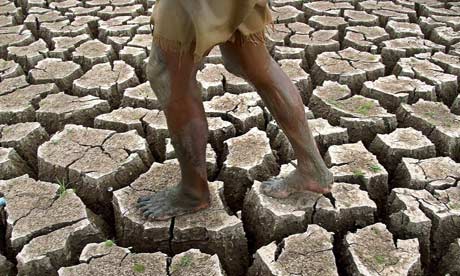當(dāng)前位置: Language Tips> 雙語新聞
分享到
 |
|
The bioenergy and CCS method is the most cost-effective way of tackling carbon emissions, say scientists. |
|
Global warming could be reversed used a combination of burning trees and crops for energy, and capturing and storing carbon dioxide underground (CCS), according to an analysis by scientists. But experts cautioned that trying such an approach after temperatures had passed dangerous levels could be problematic, as climate change reduced the number of trees available for "bioenergy". The bioenergy and CCS method was the most cost-effective way of tackling carbon emissions, said the team Chalmers University of Technology in Sweden, publishing their research in the journal Environmental Research Letters on Thursday. Such an approach could offset and even reverse other emissions from fossil fuels, they claimed. The lead author of the study, Prof Christian Azar, said it could help bring temperatures down even if they rose above the 2C level that world leaders have agreed to avoid: "Even if current political gridlock causes global warming in excess of 2C, we can reverse the temperature trend and reach targets later. This means that 2C targets, or even more ambitious targets, can remain on the table in international climate negotiations." He said that to achieve a reversal of temperatures, the combination of bioenergy and CCS would need to be combined with a huge expansion in renewable energy or nuclear power, in order to reduce emissions almost to zero. He also admitted that there was a political risk that the proposal's ability to reverse rises at a late stage could be used as an excuse for short-term inaction on emissions. CCS technology has been tested successfully on small-scale trials, but is still unproven at commercial scale anywhere in the world. Environmentalists have also questioned the carbon benefits of burning trees for power, saying that in some cases the "lifecycle" emissions are worse than coal. Dr Vivian Scott of Scottish Carbon Capture Storage at the University of Edinburgh, who was not involved with the research, said that the basis for the research's conclusion was sound, but he warned it should not be interpreted "as a 'get out of jail free' card in 50 years' time" and the idea could be hamstrung by climate change itself. "As shown in this work, Beccs [Bioenergy with Carbon Capture and Storage] could offer a way back from exceeding climate targets. However, there are potentially huge consequences to allowing an overshoot [of those targets]. A warmer climate for even a limited period could profoundly alter meteorological and ecological systems – changes which could perhaps even restrict the ability to produce the biomass on which we might be reliant to reduce the atmospheric carbon dioxide content," he said. He also said that reducing carbon emissions to zero could be a major challenge, given the track record of previous efforts to cut carbon: "Progress in addressing emissions has been woefully slow - the International Energy Agency recently announced that the average amount of carbon dioxide produced for each unit of energy generated has barely changed in the period 1990 - 2010 … in essence all the emissions mitigation efforts to date have achieved almost nothing". |
據(jù)《衛(wèi)報(bào)》7月11日?qǐng)?bào)道,根據(jù)科學(xué)家的一份分析報(bào)告,通過混合燃燒樹木和農(nóng)作物獲得的能量和利用碳捕捉與封存技術(shù)(CCS)也許可以倒轉(zhuǎn)全球變暖。但是,科學(xué)家警告,溫度已經(jīng)超過警戒線,現(xiàn)在嘗試這個(gè)方法可能會(huì)有問題,因?yàn)闅夂蜃兓瘻p少了釋放“生物能”(Bioenergy)的樹木數(shù)量。 瑞典查爾姆斯理工大學(xué)研究團(tuán)隊(duì)表示,生物能與碳捕捉與封存技術(shù)是解決碳排放問題成本效益最好的方法。他們7月11日在《環(huán)境研究快報(bào)》(Environmental Research Letters)期刊上發(fā)表了相關(guān)研究論文。他們宣稱這個(gè)方法能抵消甚至倒轉(zhuǎn)礦物燃料的其他排放量。 該項(xiàng)研究的第一作者克里斯蒂安·阿扎教授(Prof Christian Azar)表示,全球領(lǐng)袖一致同意溫度應(yīng)該控制在2C水平以內(nèi),即使溫度超過2C水平,這個(gè)方法也可以使溫度降低。他說:“即使最近的政治僵局導(dǎo)致全球變暖,溫度超過2C水平,我們?nèi)钥梢缘罐D(zhuǎn)這一溫度上升趨勢(shì),使其不久后下降到2C水平。這意味著溫度保持在2C水平這一目標(biāo),或者更遠(yuǎn)大的目標(biāo)可以繼續(xù)成為國(guó)際氣候談判的話題。” 他表示,為了達(dá)到溫度的倒轉(zhuǎn),除了使用生物能和二氧化碳捕捉與封存技術(shù),我們還需要大量膨脹可再生能源或核能,這樣可以把二氧化碳排放量幾乎減少為零。他也承認(rèn),這個(gè)計(jì)劃存在一定的政治風(fēng)險(xiǎn),在后期階段,該計(jì)劃倒轉(zhuǎn)全球變暖的能力可能會(huì)被用作排放問題短期互動(dòng)的借口。 碳捕捉與封存技術(shù)已在小型試驗(yàn)中測(cè)試成功,但是,該技術(shù)目前尚未在世界各地商業(yè)領(lǐng)域使用。環(huán)境學(xué)家也質(zhì)疑燃燒樹木獲取能量的碳效益,表示在一些例子中,“生命周期”排放比煤排放效果更差。 該研究項(xiàng)目參與者愛丁堡大學(xué)研究蘇格蘭碳捕捉與封存的維維安·斯科特博士表示這項(xiàng)研究結(jié)論的基礎(chǔ)相當(dāng)扎實(shí),但是,他警告,這并不一定是最佳解決方案,這個(gè)主意也有可能被氣候變化本身所毀掉。 他說:“正如這項(xiàng)研究所示,Beccs(生物能結(jié)合碳捕捉與封存技術(shù))可以提供技術(shù)支持,以保證溫度在氣候目標(biāo)范圍內(nèi)。但是,過分強(qiáng)調(diào)(那些目標(biāo))有可能造成嚴(yán)重的后果。短時(shí)間內(nèi)氣候變暖可能深深地改變氣象和生態(tài)系統(tǒng)——這種改變甚至可能限制生物量的產(chǎn)生。我們也許要依賴于生物量從而減少大氣中二氧化碳的含量。” 他還提到,根據(jù)過去努力減少碳排放的記錄,零碳排放是很大的挑戰(zhàn):“不幸的是,處理碳排放問題一直以來進(jìn)度緩慢——國(guó)際能源署(International Energy Agency)最近公布,1990年至2010年,每單元能量產(chǎn)出的二氧化物的汽化器平均數(shù)量幾乎沒有改變……大體上,至今所有的減排努力幾乎沒有成果。” 相關(guān)閱讀 法國(guó)科學(xué)家發(fā)現(xiàn)前所未見的巨型病毒 (翻譯:愿景 編輯:Julie) |
分享到
關(guān)注和訂閱

關(guān)于我們 | 聯(lián)系方式 | 招聘信息
電話:8610-84883645
傳真:8610-84883500
Email: languagetips@chinadaily.com.cn